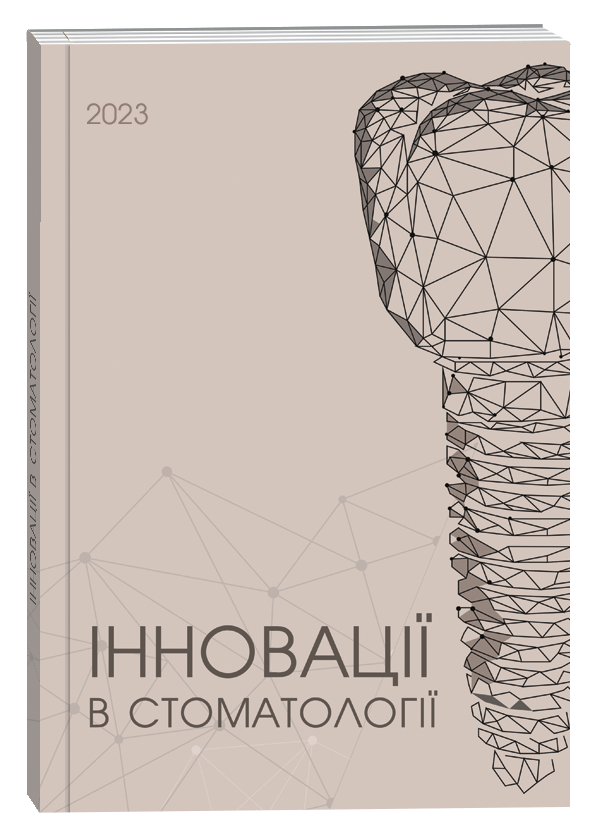CURRENT APPROACHES TO VENEER PRESCRIPTION: INDICATIONS, CONTRAINDICATIONS, AND RISKS
DOI:
https://doi.org/10.35220/2523-420X/2025.2.28Keywords:
veneers; periodontitis; diabetes mellitus; bruxism; ceramic restorations; clinical risksAbstract
In contemporary aesthetic dentistry, ceramic veneers are viewed as a minimally invasive alternative to conventional full-coverage crowns. Nonetheless, the clinical success of these restorations largely depends on periodontal status, the presence of systemic conditions–particularly diabetes mellitus–and parafunctional activity such as bruxism.The purpose of the study was to summarise up-to-date indications, contraindications, and risks associated with veneer prescription in clinical practice, based on a critical appraisal of current scientific evidence. Materials and methods. A targeted review of 36 publications dating from 2014 to 2024 was performed. Sources were retrieved from PubMed, Scopus, Web of Science, and Google Scholar using the keywords “veneers,” “periodontal health,” “diabetes,” “bruxism,” and “ceramic restorations.” Study quality was assessed according to PRISMA guidelines; data were synthesised descriptively within thematic blocks. Research results. In patients with diabetes mellitus, full-coverage veneered crowns produced a statistically significant increase in gingival index scores and periodontal pocket depth compared with non-diabetic controls. Among patients with stage III/IV periodontitis, long-term (8–13 years) veneer survival did not differ from that observed in periodontally healthy individuals, provided inflammatory control was achieved. Bruxism markedly elevated the risk of ceramic chipping; the most favourable outcomes were reported for combinations of monolithic zirconia crowns for occlusal stabilisation paired with lithium-disilicate veneers. Materials-science data further support the superiority of lithium disilicate and high-translucency zirconia in patients subjected to increased occlusal loads. Conclusions. Veneer prescription requires a comprehensive assessment of periodontal status, diabetic control, and the presence of bruxism.Adherence to well-defined indications and the selection of high-strength materials minimise complications and ensure restoration longevity.
References
Yeasmin, L., Rahman, M. M., Banik, R. K., & Islam, A. M. (2022). Effect of full veneer crown on periodontal health in diabetic and non-diabetic patients. Mymensingh Medical Journal, 31(4), 1005–1012.
Salma, M. U., Islam, M. S., Rahman, M. M., & Hossain, M. S. (2023). Impact of full veneer crown restoration on the periodontal health of posterior teeth. Journal of Bangladesh College of Physicians and Surgeons, 41(1), 46–52. https://doi.org/10.3329/jbcps.v41i1.63259
Al-Sinaidi, A., & Preethanath, R. S. (2014). The effect of fixed partial dentures on periodontal status of abutment teeth. Saudi Journal of Dental Research, 5(2), 104–108. https://doi.org/10.1016/j.ksujds.2013.11.001
Liu, S., Yan, H., & Gao, Y. (2020). Effectiveness of porcelain veneer on dental restoration in rats with periodontitis. Indian Journal of Pharmaceutical Sciences, 82, 92–96. https://doi.org/10.36468/pharmaceutical-sciences.spl.130
Tonetti, M. S., Chapple, I. L., & Jepsen, S. (2015). Primary and secondary prevention of periodontal and periimplant diseases: Introduction to, and objectives of, the 11th European Workshop on Periodontology consensus conference. Journal of Clinical Periodontology, 42(Suppl. 16), 1–4. https://doi.org/10.1111/jcpe.12382
Zhang, W., Ju, J., Rigney, T., & Tribble, G. (2014). Porphyromonas gingivalis infection increases osteoclastic bone resorption and osteoblastic bone formation in a periodontitis mouse model. BMC Oral Health, 14, 89. https://doi.org/10.1186/1472-6831-14-89
Gaß, J. A., Kwon, T., Romanos, G. E., et al. (2023). Ceramic anterior veneer restorations in periodontally compromised patients: A retrospective study. Clinical Advances in Periodontics, 13(4), 266–275. https://doi.org/10.1002/cap.10246
Simeone, P., Leofreddi, G., & Kois, J. C. (2016). Managing severe periodontal esthetic challenges: The restorative-surgical connection. International Journal of Periodontics & Restorative Dentistry, 36(1), 83–93. https://doi.org/10.11607/prd.2618
Chen, M. X., Lu, R. F., Shi, D., et al. (2021). Global, regional, and national burden of severe periodontitis, 1990–2019: An analysis of the Global Burden of Disease Study 2019. Journal of Clinical Periodontology, 48(9), 1165–1188. https://doi.org/10.1111/jcpe.13506
El Sayed, N., Baeumer, A., El Sayed, S., et al. (2019). Twenty years later: Oral health-related quality of life and standard of treatment in patients with chronic periodontitis. Journal of Periodontology, 90(4), 323–330. https://doi.org/10.1002/JPER.18-0417
Yap, A. U., & Chua, A. P. (2016). Sleep bruxism: Current knowledge and contemporary management. Journal of Conservative Dentistry, 19(5), 383–389. https://doi.org/10.4103/0972-0707.190007
Mengatto, C. M., Coelho-de-Souza, F. H., & de Souza, O. B. (2016). Sleep bruxism: Challenges and restorative solutions. Clinical, Cosmetic and Investigational Dentistry, 8, 71–77. https://doi.org/10.2147/CCIDE.S70715
Lobbezoo, F., Ahlberg, J., Raphael, K. G., et al. (2018). International consensus on the assessment of bruxism: Report of a work in progress. Journal of Oral Rehabilitation, 45(11), 837–844. https://doi.org/10.1111/joor.12663
de Souza Melo, G., Araujo, C., Corrêa, I., et al. (2018). Association of sleep bruxism with ceramic restoration failure: A systematic review and meta-analysis. Journal of Prosthetic Dentistry, 119(3), 354–362. https://doi.org/10.1016/j.prosdent.2017.07.005
Cervino, G., Minervini, G., Chaturvedi, S., et al. (2023). Influence of temporomandibular disorders and bruxism on prosthodontic rehabilitation survival: A focus on veneers. In IFMBE Proceedings – MEDICON’23 and CMBEBIH’23 (Vol. 94, pp. 695–701). Springer Nature Switzerland. https://doi.org/10.1007/978-3-031-49068-2_71
Raphael, K. G., Santiago, V., & Lobbezoo, F. (2016). Is bruxism a disorder or a behavior? Rethinking the international consensus on defining and grading of bruxism. Journal of Oral Rehabilitation, 43, 791–798. https://doi.org/10.1111/joor.12413
Manfredini, D., De Laat, A., Winocur, E., & Ahlberg, J. (2016). Why not stop looking at bruxism as a black/white condition? Aetiology could be unrelated to clinical consequences. Journal of Oral Rehabilitation, 43, 799–801. https://doi.org/10.1111/joor.12426
Raphael, K. G., Santiago, V., & Lobbezoo, F. (2016). Bruxism is a continuously distributed behaviour, but disorder decisions are dichotomous. Journal of Oral Rehabilitation, 43, 802–803. https://doi.org/10.1111/joor.12425
Svensson, P., Lavigne, G. J., & Gagnon, Y. (2016). Sleep bruxism: Definition, prevalence, classification, etiology and consequences. In M. H. Kryger, T. Roth, & W. C. Dement (Eds.), Principles and practice of sleep medicine (6th ed., pp. 1423–1426). Elsevier.
Saito, M., Yamaguchi, T., Mikami, S., et al. (2016). Weak association between sleep bruxism and obstructive sleep apnea: A sleep laboratory study. Sleep and Breathing, 20, 703–709. https://doi.org/10.1007/s11325-015-1284-x
Lobbezoo, F., Ahlberg, J., Raphael, K. G., et al. (2016). Sleep bruxism: Diagnostic considerations. In M. H. Kryger, T. Roth, & W. C. Dement (Eds.), Principles and practice of sleep medicine (6th ed., pp. 1427–1434). Elsevier.
Yachida, W., Arima, T., Castrillon, E. E., et al. (2016). Diagnostic validity of self-reported measures of sleep bruxism using an ambulatory single-channel EMG device. Journal of Prosthodontic Research, 60, 250–257. https://doi.org/10.1016/j.jpor.2016.01.001
Wetselaar, P., & Lobbezoo, F. (2016). The tooth wear evaluation system (TWES): A modular clinical guideline for the diagnosis and management planning of worn dentitions. Journal of Oral Rehabilitation, 43, 69–80. https://doi.org/10.1111/joor.12340
Yoshida, Y., Takeshima, T., Kato, T., et al. (2017). Association between patterns of jaw motor activity during sleep and clinical signs and symptoms of sleep bruxism. Journal of Sleep Research, 26, 415–421. https://doi. org/10.1111/jsr.12481
Muzalev, K., Lobbezoo, F., Janal, M. N., & Raphael, K. G. (2017). Inter-episode sleep bruxism intervals and myofascial face pain. Sleep, 40, zsx078. https://doi.org/10.1093/sleep/zsx078
Levartovsky, S., Aviv, I., Aharoni, C., et al. (2019). Complete rehabilitation of patients with bruxism by veneered and non-veneered zirconia restorations with an increased vertical dimension of occlusion: An observational case-series study. Journal of Prosthodontic Research, 63, 440–446. https://doi.org/10.1016/j.jpor.2019.02.006
Ahci, S., Bal, B., Benbir-Senel, G., et al. (2022). Polysomnographic characteristics of sleep-related bruxism: What are the determinant factors for temporomandibular disorders? Cranio: The Journal of Craniomandibular & Sleep Practice, 40, 544–550. https://doi.org/10.1080/08869634.2021.2014167
Moreira, A., Freitas, F., Marques, D., & Caramês, J. (2019). Aesthetic rehabilitation of a patient with bruxism using ceramic veneers and overlays combined with four-point monolithic zirconia crowns for occlusal stabilization: A 4-year follow-up. Case Reports in Dentistry, 2019, 1640563. https://doi.org/10.1155/2019/1640563
Moreira, A., Freitas, F., Marques, D., & Caramês, J. (2019). Aesthetic rehabilitation of a patient with bruxism using ceramic veneers and overlays combined with four-point monolithic zirconia crowns for occlusal stabilization: A 4-year follow-up. Case Reports in Dentistry, 2019, 63–70. https://doi.org/10.1155/2019/1640563
Abdulmajeed, A. A., Lim, K. G., Närhi, T. O., & Cooper, L. F. (2016). Complete-arch implant-supported monolithic zirconia fixed dental prostheses: A systematic review. Journal of Prosthetic Dentistry, 115(6), 672–677.e1. https://doi.org/10.1016/j.prosdent.2015.08.025
Rashid, H., Sheikh, Z., Misbahuddin, S., et al. (2016). Advancements in all-ceramics for dental restorations and their effect on the wear of opposing dentition. European Journal of Dentistry, 10(4), 583–588. https://doi.org/10.4103/1305-7456.195170
Mesko, M. E., Cho, S. H., Rupf, S., et al. (2016). Rehabilitation of severely worn teeth: A systematic review. Journal of Dentistry, 48, 9–15. https://doi.org/10.1016/j.jdent.2016.03.003
Hansen, T. L., van Dijken, J. W. V., Hede, K. C., et al. (2018). Monolithic zirconia crowns in the aesthetic zone in heavy grinders with severe tooth wear: An observational case-series. Journal of Dentistry, 72, 14–20. https://doi. org/10.1016/j.jdent.2018.03.003
Konstantinidis, I., Papalexopoulos, A., Andreadis, G., et al. (2018). Clinical outcomes of monolithic zirconia crowns with CAD/CAM technology: A 1-year prospective clinical study of 65 patients. International Journal of Environmental Research and Public Health, 15(11), 2553. https://doi.org/10.3390/ijerph15112553
Floriani, F., Coelho, N. F., Linhares, L. A., et al. (2024). Semidirect resin composite veneers in a patient with bruxism. Case Reports in Dentistry, 2024, 5572481. https://doi.org/10.1155/2024/5572481
Sperber, G. H. (2017). Dental wear: Attrition, erosion, and abrasion – a palaeo-odontological approach. Dentistry Journal, 5(2), 19–27. https://doi.org/10.3390/dj5020019








